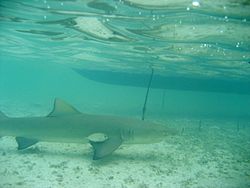Difference between revisions of "AY Honors/Species Account/Negaprion brevirostris"
| (One intermediate revision by the same user not shown) | |||
| Line 25: | Line 25: | ||
The '''lemon shark''', ''Negaprion brevirostris'', is a [[shark]] in the family [[Carcharhinidae]], can grow to {{convert|10|ft|m}} long.<ref>[http://www.sharksurvivor.com/sharks/lemonshark.htm Lemon Shark] - SharkSurvivor.com</ref> It is known as the lemon shark because of its unique yellow coloration. | The '''lemon shark''', ''Negaprion brevirostris'', is a [[shark]] in the family [[Carcharhinidae]], can grow to {{convert|10|ft|m}} long.<ref>[http://www.sharksurvivor.com/sharks/lemonshark.htm Lemon Shark] - SharkSurvivor.com</ref> It is known as the lemon shark because of its unique yellow coloration. | ||
| − | ==Description | + | ==Description |
| − | It's | + | The Lemon Shark is actually grey not yellow. It's called the Lemon Shark because of they way it smells. It's very unusual and scientist are trying to discover how it is like that. It has a blunt nose with a spiracle. It is very long in size but seems small when far away. |
==Distribution and habitat== | ==Distribution and habitat== | ||
Revision as of 18:41, 13 April 2013
Template:Taxobox The lemon shark, Negaprion brevirostris, is a shark in the family Carcharhinidae, can grow to Template:Convert long.& It is known as the lemon shark because of its unique yellow coloration.
==Description The Lemon Shark is actually grey not yellow. It's called the Lemon Shark because of they way it smells. It's very unusual and scientist are trying to discover how it is like that. It has a blunt nose with a spiracle. It is very long in size but seems small when far away.
Distribution and habitat
The lemon shark is found mainly along the subtropical and tropical parts of the Atlantic and Pacific coasts of North and South America, and around Pacific islands. The longest lemon shark recorded was Template:Convert long, but they are usually Template:Convert. They inhabit mostly tropical waters, stay at moderate depths, and are often accompanied by remoras.
Reproduction
Lemon sharks are viviparous, females giving birth to between four and 17 young every other year in warm and shallow lagoons. The young have to fend for themselves from birth, and remain in shallow water near mangroves until they grow larger. With increasing size, they venture further away from their birthplaces. At maturity, at a size of 1.5–2 m and an age of 12–15 years, they leave shallow water and move into deeper waters offshore. However, little is known of this life stage.
Recent work in genetics by Kevin Feldheim and Samuel Gruber may suggest adult sharks travel hundreds of kilometers to mate. Another possibility is that populations far apart may have been separated in recent times. Further research is needed for an understanding of the lemon shark's breeding behavior and ecology.
Importance to humans

Lemon sharks are a popular choice for study by scientists, as they survive well in captivity, unlike many other species, such as the great white, which die in captivity because of food refusal. The species is the best known of all sharks in terms of behavior and ecology, mainly because of the work of Samuel Gruber at the University of Miami, who has been studying the lemon shark both in the field and in the laboratory since 1967. The population around the Bimini Islands in the western Bahamas, where Gruber's Bimini Biological Field Station is situated, is probably the best known of all shark populations. As of 2007, this population is experiencing a severe decline and may disappear altogether as a result of destruction of the mangroves for construction of a golf resort. Of the 22 known lemon shark attacks since 1580, none has resulted in death.
Electroreceptors
All sharks have electroreceptors concentrated in their heads, called the ampullae of Lorenzini. These receptors detect electrical pulses emitted by potential prey. Lemon sharks are bottom dwellers. They have very poor eyesight and cannot see well to find their food, but are equipped with extremely sensitive and accurate electroreceptors in the nose.
See also
References
- ↑ Lemon Shark - SharkSurvivor.com
- Template:ITIS
- Template:FishBase species
- Washington Post, 2005, Aug. 22nd: "Scientists Fear Oceans on the Cusp Of a Wave of Marine Extinctions"
